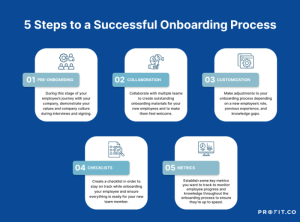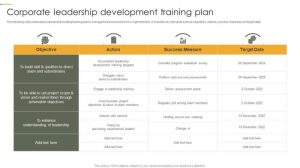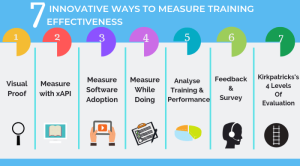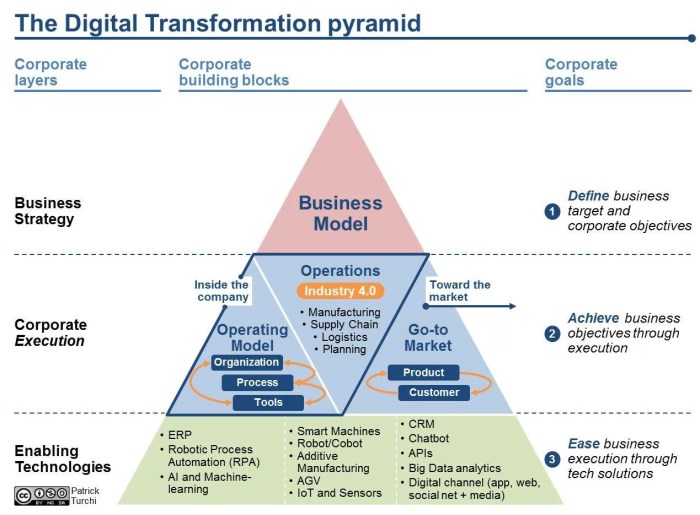
Embracing digital transformation is no longer a luxury for corporations; it’s a necessity for survival and growth in today’s rapidly evolving business landscape. This exploration delves into the multifaceted strategies and impactful changes that organizations undergo to leverage technology for enhanced efficiency, profitability, and competitive advantage. We will examine how data analytics informs decision-making, the challenges encountered during implementation, and the crucial role of employee training in successful transformation.
From optimizing marketing campaigns and streamlining sales processes to revolutionizing operational efficiency and reshaping human resource strategies, the impact of digital transformation permeates every aspect of a modern corporation. This examination will provide a comprehensive overview of the journey, highlighting both the opportunities and the potential pitfalls along the way.
Defining Digital Transformation in Corporate Settings
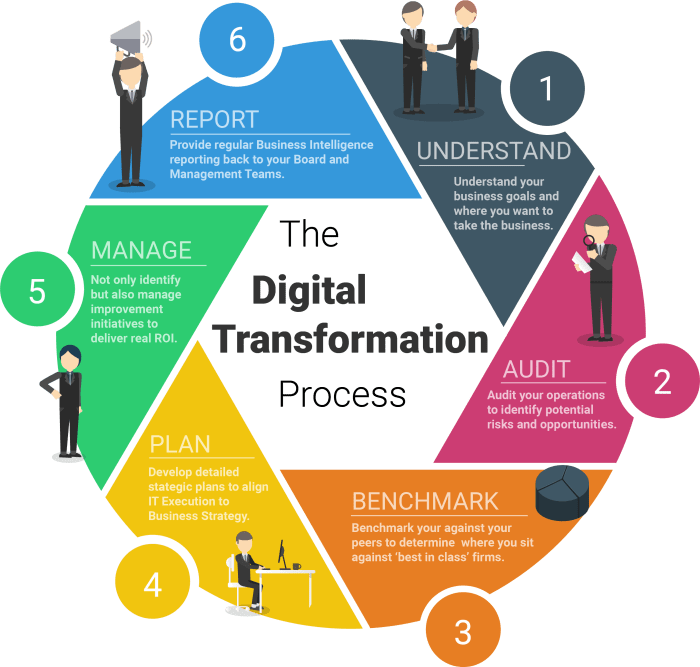
Digital transformation is more than just adopting new technologies; it’s a fundamental shift in how a company operates, interacts with customers, and creates value. It involves reimagining business processes, leveraging data-driven insights, and embracing a culture of innovation to achieve strategic goals. This multifaceted process impacts every aspect of an organization, from its internal operations to its external market positioning.Digital transformation encompasses the integration of digital technologies into all areas of a business, fundamentally changing how it operates and delivers value to customers.
It’s not simply about implementing new software or hardware; it’s a holistic approach requiring changes in strategy, processes, culture, and people. This involves a deep understanding of the business’s current state, its future aspirations, and the capabilities required to bridge the gap.
Characteristics of Successful Digital Transformations
Successful digital transformations are characterized by a clear vision, strong leadership commitment, a data-driven approach, and a culture that embraces change. Organizations that successfully navigate this journey prioritize agility, collaboration, and continuous improvement. Conversely, unsuccessful transformations often lack a well-defined strategy, fail to secure executive buy-in, and struggle to adapt to the evolving digital landscape. Effective change management, robust cybersecurity measures, and a focus on employee training are also crucial for success.
Examples of Digital Transformation Across Industries
Different industries approach digital transformation with unique strategies tailored to their specific needs and challenges. For example, in the retail industry, companies like Amazon have revolutionized the customer experience through e-commerce, personalized recommendations, and efficient supply chain management. In healthcare, telehealth platforms and electronic health records are improving patient care and operational efficiency. The financial services sector is leveraging AI and machine learning for fraud detection, risk management, and personalized financial advice.
Finally, in manufacturing, the adoption of Industry 4.0 technologies like IoT and robotics is driving automation, optimizing production processes, and improving product quality.
Comparison of Traditional and Digitally Transformed Business Models
| Industry | Traditional Model | Digitally Transformed Model | Key Differences |
|---|---|---|---|
| Retail | Brick-and-mortar stores, limited online presence, manual inventory management | Omnichannel presence (online and offline), personalized customer experiences, data-driven inventory management, AI-powered recommendations | Increased customer reach, enhanced personalization, optimized inventory, improved efficiency |
| Healthcare | Paper-based records, in-person appointments, limited data sharing | Electronic health records (EHRs), telehealth consultations, remote patient monitoring, data analytics for improved diagnosis and treatment | Improved patient access, enhanced data sharing, better diagnosis and treatment, increased efficiency |
| Manufacturing | Manual processes, limited automation, reactive maintenance | Automated production lines, predictive maintenance using IoT sensors, data analytics for process optimization, real-time monitoring | Increased efficiency, improved quality control, reduced downtime, optimized resource allocation |
| Financial Services | Branch-based operations, manual processes, limited data analysis | Online banking, mobile apps, AI-powered fraud detection, personalized financial advice, algorithmic trading | Increased customer convenience, improved risk management, enhanced security, personalized services |
Strategies for Achieving Corporate Growth Through Digital Transformation

Digital transformation isn’t just about adopting new technologies; it’s about fundamentally reshaping how a company operates to achieve sustainable growth. By strategically integrating digital tools and processes, businesses can enhance efficiency, improve customer experiences, and unlock new revenue streams. This section explores key strategies for leveraging digital transformation to fuel corporate expansion.
Successful digital transformation hinges on a clear understanding of a company’s unique strengths, weaknesses, opportunities, and threats (SWOT analysis). A well-defined strategy, informed by robust data analysis, is crucial for maximizing the return on investment and avoiding costly pitfalls. Furthermore, a strong commitment from leadership and a culture that embraces change are essential prerequisites for successful implementation.
Five Strategies for Leveraging Digital Transformation for Growth
Companies can utilize various strategies to achieve growth through digital transformation. These strategies, while distinct, often complement each other and should be considered holistically within a broader digital strategy. The following five strategies represent a diverse range of approaches.
- Enhanced Customer Experience (CX): Implementing personalized marketing campaigns, creating seamless omnichannel experiences, and providing superior customer service through digital channels (e.g., chatbots, AI-powered support). This leads to increased customer loyalty and advocacy, driving organic growth.
- Operational Efficiency Improvements: Automating repetitive tasks, optimizing supply chains through technologies like blockchain and IoT, and streamlining internal processes using Robotic Process Automation (RPA) to reduce costs and improve productivity.
- New Product and Service Development: Utilizing data analytics to identify emerging market trends and customer needs, enabling the creation of innovative digital products and services that cater to these demands and generate new revenue streams. This could involve developing mobile apps, subscription services, or AI-powered solutions.
- Data-Driven Decision Making: Implementing robust data analytics capabilities to gain actionable insights from customer data, market trends, and operational performance. This enables informed strategic decision-making across all departments, leading to improved resource allocation and more effective strategies.
- Expanding into New Markets: Leveraging digital channels to reach new customer segments and geographical markets with reduced overhead. This could involve using e-commerce platforms, social media marketing, and targeted digital advertising campaigns to expand reach beyond traditional limitations.
The Role of Data Analytics in Informing and Optimizing Growth Strategies
Data analytics plays a pivotal role in all five strategies. By analyzing vast amounts of data, companies can gain a deep understanding of customer behavior, market dynamics, and operational efficiency. This allows for more informed decision-making, leading to improved resource allocation, more effective marketing campaigns, and the development of innovative products and services. For example, predictive analytics can forecast future demand, enabling companies to optimize inventory management and prevent stockouts or overstocking.
Step-by-Step Implementation Plan: Enhanced Customer Experience
This plan Artikels the implementation of an enhanced customer experience strategy. This focuses on creating a seamless and personalized experience across all touchpoints.
- Assessment (Month 1-2): Conduct a thorough assessment of the current customer journey, identifying pain points and areas for improvement. This involves analyzing customer feedback, website analytics, and sales data.
- Technology Selection (Month 3-4): Select and implement the necessary technologies to support the enhanced CX strategy. This might include a CRM system, marketing automation software, and a chatbot platform. Resource allocation: $50,000 for software licenses and implementation.
- Implementation (Month 5-8): Integrate the chosen technologies into existing systems and processes. Train employees on the new tools and processes. Resource allocation: $20,000 for training and internal support.
- Testing and Refinement (Month 9-10): Conduct A/B testing to optimize the customer experience and measure the effectiveness of the implemented changes. Resource allocation: $10,000 for testing and analysis.
- Ongoing Monitoring and Optimization (Month 11 onwards): Continuously monitor customer feedback and analytics data to identify areas for further improvement and adapt the strategy accordingly.
Advantages and Disadvantages of Each Strategy
Each strategy offers unique benefits and drawbacks that should be carefully considered.
| Strategy | Advantages | Disadvantages |
|---|---|---|
| Enhanced Customer Experience | Increased customer loyalty, improved brand reputation, higher customer lifetime value. | Requires significant investment in technology and training, ongoing monitoring and optimization are crucial. |
| Operational Efficiency Improvements | Reduced costs, increased productivity, improved scalability. | Requires significant upfront investment in technology and process redesign, potential job displacement. |
| New Product and Service Development | Creation of new revenue streams, increased market share, enhanced competitive advantage. | High risk of failure, requires significant investment in R&D, market research is crucial. |
| Data-Driven Decision Making | Improved strategic decision-making, optimized resource allocation, enhanced business performance. | Requires skilled data analysts and data scientists, data security and privacy concerns. |
| Expanding into New Markets | Increased market reach, diversification of revenue streams, enhanced brand visibility. | Increased competition, cultural and language barriers, higher marketing costs. |
Ultimately, corporate growth through digital transformation hinges on a strategic, data-driven approach, coupled with a commitment to continuous learning and adaptation. By carefully considering the challenges, implementing robust strategies, and measuring progress through key performance indicators, organizations can unlock unprecedented opportunities for expansion and sustained success in the digital age. The successful navigation of this transformative journey requires a clear vision, decisive leadership, and a willingness to embrace change at all levels of the organization.
Question Bank
What is the biggest risk associated with digital transformation?
Resistance to change within the organization is often cited as the biggest hurdle. Lack of employee buy-in and insufficient training can significantly hinder successful implementation.
How long does a typical digital transformation take?
The timeframe varies greatly depending on the organization’s size, complexity, and the scope of the transformation. It can range from several months to several years.
What is the return on investment (ROI) of digital transformation?
ROI can be significant but is highly dependent on the specific strategies implemented and the effectiveness of their execution. Careful measurement and tracking of KPIs are essential to determine the actual return.
How can companies ensure employee buy-in for digital transformation?
Effective communication, comprehensive training, clear demonstration of benefits, and involving employees in the process are key to fostering acceptance and enthusiasm.

